Before we get started,
Ukraine, again, briefly
Here is a good account of the history of Orthodoxy in Ukraine vis-a-vis the Russian Orthodox Patriarchate and the Ecumenical Patriarchate. (Thanks to my cousin Jacklyn for finding this.) https://ecfr.eu/publication/defender_of_the_faith_how_ukraines_orthodox_split_threatens_russia/
So today the President of the country with the greatest number of Eastern Orthodox Christians (Russia – 62 million) is out to brutally destroy the country with the second greatest number of Orthodox (Ukraine – 36 million), with the blessing of the Russian Orthodox Church – and thereby is putting the peace of the whole world in jeopardy.
Lord Jesus Christ, Son of God, have mercy on us all.
Ukrainian (from Orthodox Christian Chants)
The First Sunday of Great Lent
As usual, there’s a lot to cover today.
Epistle: Hebrews 11:24-26, 32-40
All human beings are waiting.
People are waiting to get out of school, for their true love to come along, for a spouse and children, for a better job, for relief from disease. Some people are waiting desperately for a decent meal. Some who are fortunate wait for retirement – and, whether we like it or not, we all wait for death.
At this time of year, here in the northern climes, everyone waits eargerly for spring.
Christians also wait, but in a different way.
As spring approaches, we have our “Lenten spring”. We fast, acting out all our waiting by use of our stomachs – “the way to our hearts”, as they say. Our Paschal Feast (mmm… meat! cheese! wine! chocolate!) will be our gastronomic sign of what we wait most for: the Great Banquet in the Kingdom of Heaven, when all the good things we have desired will be fulfilled, so that (as Saint Basil the Great wrote) “when from this life I have passed in the hope of life eternal, may I attain to everlasting rest, where the sound of those who celebrate is unceasing, and unending is the delight of those who behold the ineffable beauty of Your Countenance. For You are, indeed, the true object of our desire and the inexpressible gladness of those who love You, O Christ our God”. (Every time I pray that, my heart leaps.)
![]() The Epistle to the Hebrews reminds us that in Old Testament times, the Jews also waited: for freedom from slavery in Egypt, for their promised land “flowing with milk and honey”, for their return from Babylon, and above all for the coming of their Messiah. Sunday’s reading speaks of the heroes and heroines of those days
The Epistle to the Hebrews reminds us that in Old Testament times, the Jews also waited: for freedom from slavery in Egypt, for their promised land “flowing with milk and honey”, for their return from Babylon, and above all for the coming of their Messiah. Sunday’s reading speaks of the heroes and heroines of those days
We hear only part of a long list of them: Abraham and Sarah, who at God’s command in faith left Mesopotamia to go to the Holy Land, their true homeland which they had never seen. Isaac, Jacob, Joseph. Moses who in faith led the Hebrews out of Egypt and slavery towards that promised land which they had never seen. And many more “who by their faith, did not receive what was promised, since God had foreseen something better for us, that apart from us they should not be made perfect”.
from “A Reader’s Guide to Orthodox Icons”
So, concludes the Epistle reading, with them “let us run with endurance the race that is set before us”.
Gospel Reading: John 1:43-51
Do want to know how long our Orthodox lectionary (assigned Scripture readings) has been around? Our Lenten Sunday Gospel readings (as well as our weekday readings from the Old Testament) were originally last-minute instructions for catechumens in the early centuries, who awaited Baptism on Pascha.
The Sunday Gospels taught them the single most important thing they needed to know: Who is Jesus of Nazareth? We also need to be reminded of that. But before we get to that, let’s look at the story itself.
“Come and see!”
Some view this as strictly a serious theological dialog. For myself, I find the story entertaining, as the Lord cleverly “teases” Nathaniel into belief. (This is the first of Saint John’s several enjoyable dialogs. I think he would have made a fine modern dramatist or short story writer.)
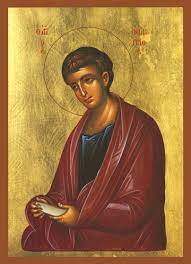 This and all following icons with permission of Saint Isaac’s Skete at skete.com
This and all following icons with permission of Saint Isaac’s Skete at skete.com
The Lord has just called Philip right to follow Him. Philip found Nathanael * and said, excitedly: “We have found Him of whom Moses in the law and also the prophets wrote, Jesus of Nazareth, the son of Joseph.” (Of course, he didn’t yet know about the Virgin Birth.)
- “Nathanael” is generally believed to be another name for the Apostle Bartholomew.
Nathanael replies: “Can anything good come out of Nazareth?” Really, Nathanael! what a snarky shallow “put-down”. No matter: it was a good question. Nazareth was an obscure village up in the hills of Galilee, not even mentioned in the Old Testament.
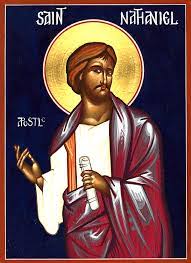 So, as I read it, Jesus now decides to startle Nathanael, loosen him up, so he will be open to what is about to come. (He often does this to shake people into faith. I speak from experience.)
So, as I read it, Jesus now decides to startle Nathanael, loosen him up, so he will be open to what is about to come. (He often does this to shake people into faith. I speak from experience.)
Philip says “Come and see!” (This is a topic we will return to later, when we come to this Sunday’s other theme: the restoration of the holy icons.)
So Nathanael does “come and see”. Jesus sees him and says: “Look, an Israelite in whom there is no guile!” – no pretense or dissembling in this man! The Lord is teasing, of course, “setting him up” – but Nathanael, in his shallow pride, actually takes Him seriously: “Rabbi, how do you know me?” Nathanael thinks pretty highly of himself, does he not? As I read it, Jesus thinks: Now, smart guy, I’ll show you Who has “come out of Nazareth”! “Before Philip called you, I saw you under the fig tree.”
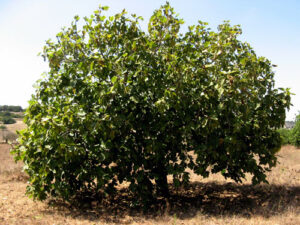 We need to stop for a bit of dendrological study: Fig trees in that region spread very wide with branches and leaves so thick they provide shade and escape from the noonday heat, often hanging so low that a person could hide there and take a little nap.
We need to stop for a bit of dendrological study: Fig trees in that region spread very wide with branches and leaves so thick they provide shade and escape from the noonday heat, often hanging so low that a person could hide there and take a little nap.
Ficus caricus
Nathanael is amazed. “This Man was nowhere near me. Besides, how could He see me under there?” He cries: “Rabbi, you are the Son of God. You are the King of Israel!” Shallow disbelief often leads to shallow belief. (Though I wonder if there was more to their dialog than John included.)
Jesus says: “You believe because I saw you under the fig tree? You will see greater things than that. You will see heaven opened and angels of God ascending and descending on the Son of Man” – as indeed he did.
That was the beginning of the story of how shallow, superficial Nathanael (Bartholomew) became a faithful Apostle. He proclaimed the Gospel in Asia Minor, then east as far as India, then north into Armenia where he was (don’t read this if you have a weak stomach) crucified, and when that didn’t kill him they skinned him alive, and when that didn’t kill him finally they beheaded him.
Holy Apostle Nathanael, pray to Christ our God for the salvation of our souls.
Now to the point of the story.
Who is Jesus of Nazareth?

If you have not, read this Gospel story and see all the titles Our Lord Jesus is given here.
He is RabbI (“teacher”) whose teachings we are to follow.
He is Son of God, divine like God his Father, just as a human son is human like his father.
He is King of Israel, the Messiah, the Christ (“the Anointed One”).
He is Son of Man, which means
- He is truly Man. This was a big issue in early times, since there were some (Gnostics) who insisted He only appeared to be human.
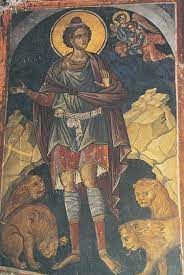 The title also meant that He is the King and Savior of all mankind. From the prophet Daniel: “I was watching in the night visions, and behold, One like the Son of Man, coming with the clouds of heaven! He came to the Ancient of Days, and they brought Him near before Him. Then to Him was given dominion and glory and a kingdom, that all peoples, nations, and languages should serve Him. His dominion is an everlasting dominion, which shall not pass away, and His kingdom the one which shall not be destroyed.” Daniel 7:13-14
The title also meant that He is the King and Savior of all mankind. From the prophet Daniel: “I was watching in the night visions, and behold, One like the Son of Man, coming with the clouds of heaven! He came to the Ancient of Days, and they brought Him near before Him. Then to Him was given dominion and glory and a kingdom, that all peoples, nations, and languages should serve Him. His dominion is an everlasting dominion, which shall not pass away, and His kingdom the one which shall not be destroyed.” Daniel 7:13-14
He is Jacob’s Ladder, uniting Heaven and earth. Long before, the Patriarch Jacob “had a dream in which he saw a stairway resting on the earth, with its top reaching to heaven, and the angels of God were ascending and descending on it.” Genesis 28:12 (Remember above what He said to Nathanael.)
He is the One who sees all things – sees us even if we try to hide under a fig tree. He saw into Nathanael’s heart and soul, and he can see into yours, too, you catechumens – and into ours, as well – so don’t try to hide anything from Him.
All this in this one short story! That’s plenty for the catechumens to chew on this week. And for us, too.
The Sunday of Orthodoxy
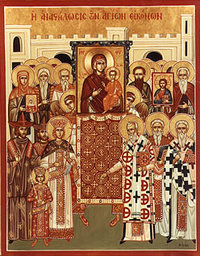 On the First Sunday of Great Lent in the year 842 the Empress Theodora and Patriarch Methodios led a procession of icons into the Great Church Agia Sophia in Constantinople, thus ending for all time the Iconoclastic controversy in the Orthodox Church. Ever since we have been celebrating that event on the First Sunday of Lent each year. We process icons ’round the church, and sometimes even outdoors/
On the First Sunday of Great Lent in the year 842 the Empress Theodora and Patriarch Methodios led a procession of icons into the Great Church Agia Sophia in Constantinople, thus ending for all time the Iconoclastic controversy in the Orthodox Church. Ever since we have been celebrating that event on the First Sunday of Lent each year. We process icons ’round the church, and sometimes even outdoors/
from Saint Symeon Orthodox Church, Birmingham, Alabama
There’s no room today to go into detail. There is much more about the Iconoclastic controversy elsewhere online. Or if you want my simple history and explanation, you can find it here: https://frbillsorthodoxblog.com/2019/03/29/112-the-icon-part-two-iconoclasm-the-seventh-council-and-after-that/
The Iconoclastic controversy had raged off and on in the Church since the year 726, when Emperor Leo the Isaurian (he sounds nasty, doesn’t he?) forbade the use of the holy icons in churches, in public, in homes – everywhere. They were taken down, burned, trampled on, destroyed. Innumerable ancient treasures were lost. Why did he do this? He never explained.
What was so bad about getting rid of pictures? It reduced the Faith to doctrines, to teachings, to laws. But Jesus Christ is God in the flesh. Christ lives in His saints, in His people. the Faith needs to be seen, experienced. It isn’t enough just to “come and hear”. With Nathanael, we need to “come and see!” God is Personal, Tri-Personal. We are persons. Christianity is above all a personal religion.
We Orthodox go to church, and we see Our Lord Jesus Christ and worship surrounded by His holy Family, the Church, the people of God – both those living, standing besides us, and the heroes and heroines who have gone before us.
Icons are our “windows into heaven”, through which we are in personal visible touch with Christ and His Mother and all the saints. ![]() They reach out to us. We can reach in to them. I became Orthodox because Saint Nicholas, to my utter shock, “grabbed hold of me” through this icon. (If you don’t understand how icons “work”, trying living and praying with an icon for a while.)
They reach out to us. We can reach in to them. I became Orthodox because Saint Nicholas, to my utter shock, “grabbed hold of me” through this icon. (If you don’t understand how icons “work”, trying living and praying with an icon for a while.)
Destroying the icons naturally met stiff resistance from most ordinary folks who treasured their family icons, from most monastics and a few brave bishops. There were riots. Those who objected publicly were subjected to persecution – torture, imprisonment, exile, even death. Many others, chiefly those who valued their incomes – bishops and parish clergy, for example – went along with the iconoclasts.
In 787, during a lull in the persecution, the Seventh Ecumenical Council met and explained and clarified the Church’s theology of the εἰκών (“image/icon”), declaring images not only permissible but also necessary, as a witness to the Incarnation of God in Jesus Christ, for “whoever has seem Me has seen the Father”. “We have seen the glory of God in the face of Jesus Christ.” And as a witness to Christ’s living presence in his saints.
In other words the Iconoclastic controversy was not chiefly about pictures in church. It was about the Faith of the Church.
Orthodox Unity in the Faith
That was the last theological controversy in the Holy Orthodox Church. Well, except for a minor kerfuffle in the Fourteenth Century, which was quickly settled, and in the Seventeenth Century we did  have (believe it or not) a Calvinist Patriarch of Constantinople. However, hardly anybody paid attention to him, and he was so much trouble that the Turks had him strangled, or some say drowned. (Sorry, no icon for him.)
have (believe it or not) a Calvinist Patriarch of Constantinople. However, hardly anybody paid attention to him, and he was so much trouble that the Turks had him strangled, or some say drowned. (Sorry, no icon for him.)
available at amazon.com
And that was it.
So this Sunday really should be called “The Sunday of the Orthodox Faith”.
Should we Orthodox brag about our theological unity? No. No. No! NO! This has been the work of the Holy Spirit of God – despite us Orthodox, despite our fighting about this and that, despite our jurisdictional controversies, despite our continual battling about who’s in charge of whom and what and where, despite our personal rivalries and battles, despite our political rivalries and battles, and tragically I do mean battles. Clearly, plainly, obviously and without doubt, this has been the work of the Holy Spirit of God.
By the way, please pray for our Christian brothers and sisters elsewhere who are forever struggling to try to define and preserve the Faith. It is so hard. Believe me, I know. I was there.
This icon shows the Orthodox ship sailing smoothly past heretics and others who would try to sink her. What it does not show is all the squabbling on board.
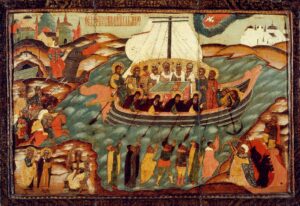
Russian, 17th c
Father Alexander Schmemann, Dean of Saint Vladimir’s Seminary in New York, was once overheard to say: “The Orthodox Church is the right Church filled with all the wrong people!” Well, ever since Eden the whole world is filled with the “wrong people”.
Nevertheless, we Orthodox, through no virtue of our own, have been given this wonderful gift from God: genuine unity in the Faith, “built on the foundation of the apostles and prophets, Jesus Christ Himself being the chief cornerstone”. Ephesians 2:20 This is one of the signs of the true and authentic Church of Jesus Christ.
However…
… “though I have the gift of prophecy, and understand all mysteries and all knowledge, and though I have all faith, so that I could remove mountains, but have not love, I am nothing.” I Corinthians 13:2
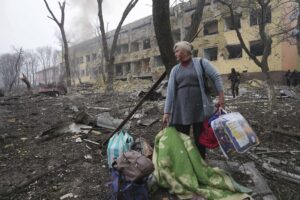
Next Two Weeks: Lent continues
Thank you for your insights and teachings Father Bill.
Thanks, Mats. It’s nice to be appreciated.